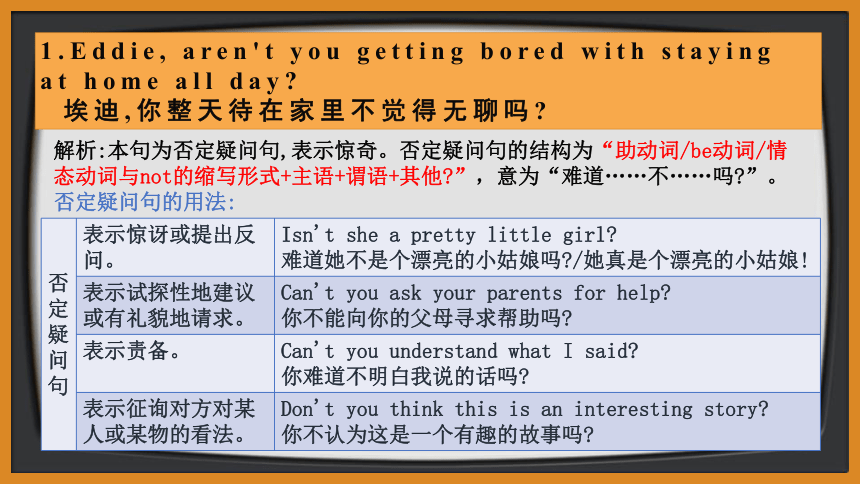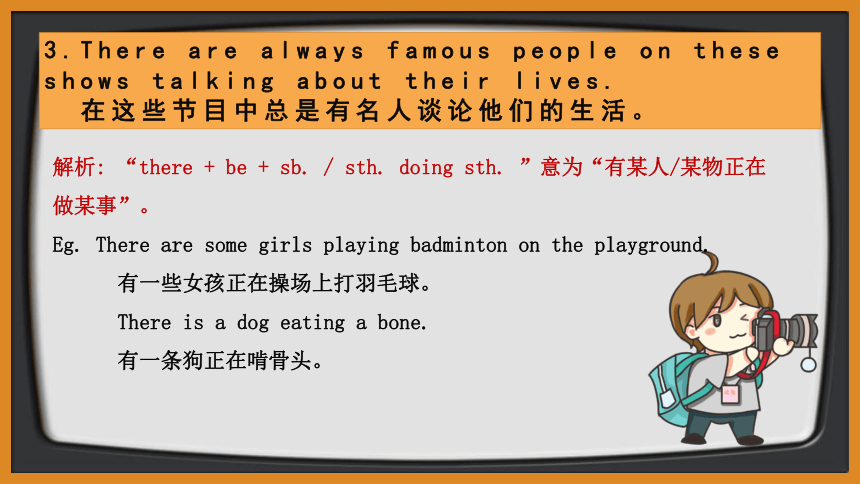Unit6 TV programmes课件(共37张PPT) 牛津译林版九年级英语上册
文档属性
| 名称 | Unit6 TV programmes课件(共37张PPT) 牛津译林版九年级英语上册 |

|
|
| 格式 | pptx | ||
| 文件大小 | 11.7MB | ||
| 资源类型 | 教案 | ||
| 版本资源 | 牛津译林版 | ||
| 科目 | 英语 | ||
| 更新时间 | 2025-02-03 09:00:15 | ||
图片预览












文档简介
(共37张PPT)
TV programmes
汇报人:Sally
Unit 6
Welcome to the unit
第一章
1.Eddie, aren't you getting bored with staying at home all day
埃迪,你整天待在家里不觉得无聊吗
解析:本句为否定疑问句,表示惊奇。否定疑问句的结构为“助动词/be动词/情态动词与not的缩写形式+主语+谓语+其他 ”,意为“难道……不……吗 ”。
否定疑问句的用法:
否定疑问句 表示惊讶或提出反问。 Isn't she a pretty little girl
难道她不是个漂亮的小姑娘吗 /她真是个漂亮的小姑娘!
表示试探性地建议或有礼貌地请求。 Can't you ask your parents for help
你不能向你的父母寻求帮助吗
表示责备。 Can't you understand what I said
你难道不明白我说的话吗
表示征询对方对某人或某物的看法。 Don't you think this is an interesting story
你不认为这是一个有趣的故事吗
注意:回答否定疑问句要根据实际情况,且前后形式要一致。事实是肯定的,回答用yes,后跟肯定的简略句;事实是否定的,回答用no,后跟否定的简略句。
答语中的 yes 译成“不”,no 译成“是”。
◆—Don't you like living in London
你难道不喜欢住在伦敦吗
一Yes , I do. 不,我喜欢。
No, I don’t. 是的,我不喜欢。
2.A dog's work is never done!
狗的活儿从来做不完!
解析: done 在此作形容词,意为“完毕,结束”,与finished同义。
eg. The job is nearly done. 工作快做完了。
I am done with the film Your Name.我看完了《你的名字》这部电影。
拓展: done 的其他用法:
done 形容词,意为“熟的,煮好的”。 Are the noodles done yet
面条煮好了没有
done 为 do 的过去分词。 You have done a good job.
你的工作做得不错。
3.There are always famous people on these shows talking about their lives.
在这些节目中总是有名人谈论他们的生活。
解析: “there + be + sb. / sth. doing sth. ”意为“有某人/某物正在做某事”。
Eg. There are some girls playing badminton on the playground.
有一些女孩正在操场上打羽毛球。
There is a dog eating a bone.
有一条狗正在啃骨头。
Reading
第二章
1.A weekly round-up of what is happening in sport, with up-to-date information.
一周体育新闻摘要及最新消息。
结构分析: 本句是一个省略句,其完整形式为“Here is a weekly round-up of...”。直接将句子的中心词放在开头,省去一些不重要的词,是新闻报道或节目导读的语言风格,以引起读者的注意和兴趣。
解析1: weekly 在此作形容词,意为“每周的”,仅用于名词前作定语。
Eg. This is a weekly magazine. 这是周刊杂志。
拓展:weekly 还可作副词,意为“每周地”; 还可作可数名词,意为“周报;周刊”
Eg. They go to the gym weekly.
他们每周去健身房。
This weekly comes out every Friday.
这份周报每周五出版。
联想: 类似的词还有 daily 每天的/地;日报; monthly 每月的/地;月刊
解析2: up-to-date形容词,意为“最新的;现代的”。
Eg. I want to find an up-to-date map of Nantong.
我想找到一份南通的最新地图。
联想: out-of-date形容词,意为“(信息)过时的,不再正确的”。
Eg. The information in the tourist guide is already out-of-date.
旅游指南上的资料已经过时。
注意:up-to-date 和 latest 意思相近,而newest是new的最高级,意为“最新的”,指物品的新旧程度。
Eg. My bike is the newest one in our class.
在我们班,我的自行车最新。
2.There are a number of interviews with famous players. 有一些对著名球员的采访。
解析: a number of 意为“一些;许多”,后接可数名词复数。
Eg. A number of students in our school like this TV programme.
我们学校许多学生喜欢这个电视节目。
辨析: a number of, the number of
a number of 意为“一些;许多”,相当于many。其后接可数名词复数。number前可加great、large等形容词修饰。其中心词是of 后的名词,“a number of +可数名词复数”作主语时,谓语动词通常用复数形式。
the number of 意为“……的数量”,其后接可数名词复数,其中心词是number, “the number of十可数名词复数”作主语时,谓语动词应用第三人称单数形式。
Eg. A number of students are in the playground.
许多学生在操场上。
The number of workers in the factory is 300.
这个工厂的工人人数是300。
3.This year's Beijing Music Awards will be covered live this Saturday.
本年度的北京音乐颁奖典礼将在这个星期六现场直播。
解析1: cover 及物动词,在此意为“报道,电视报道”。
Eg. Last year, many TV channels covered the World Cup.
去年许多电视频道报道了世界杯。
拓展:cover 可作动词,意为“包括;覆盖”; 还可作名词,意为“庇护所;封面;盖子,罩”。
解析2: live 在此作副词,意为“在现场直播,在实况直播”。
live 的其他用法:
live 作形容词,意为“现场直播的,实况转播的”。live 作形容词或副词时,其读音为/laiv/。 It is a live radio phone-in show.
这是一个现场直播的听众来电广播节目。
作动词,意为“居住”。作动词时,其读音为/liv/。 She has lived here for10 years.
她在这里住了10年了。
4.Murder in a Country House is a horror film directed by Cindy Clark, a new director. 《村舍血案》是由一位新导演--辛迪·克拉克导演的一部恐怖电影。
结构分析: 本句是一个主系表结构的简单句。
directed by Cindy Clark是过去分词短语作后置定语,修饰名词film.
a new director是Cindy Clark的同位语。
5.In the film, a wealthy doctor is found dead in his house.
在这部电影中,一位富裕的医生被发现死在家里。
解析1: be found dead 意为“被发现死了”。“be found+形容词”意为“被发现处于某种状态”,是“find十宾语十形容词”的被动结构。
其中形容词作宾语补足语。常接形容词作宾语补足语的动词还有 keep、make等。
Eg. He was found asleep on the sofa.
他被发现在沙发上睡着了。(被动语态)
She found him asleep on the sofa.
她发现他在沙发上睡着了。(主动语态)
归纳: find后常跟的几种形式:
find+ that 从句
find+ it (形式宾语) +形容词(宾语补足语) +to do sth.(真正宾语)
find+宾语+宾语补足语(形容词/名词/V-ing 形式等)
6.In the documentary, you can see scenes from India, one of the few places where tigers still live in the wild.在这部纪录片里,你可以领略印度风光,这里是老虎仍然在野外生存的少数几个地方之一。
结构分析:本句中,one of the few places. . .in the wild 是India 的同位语。
where tigers still live in the wild 是where引导的定语从句,修饰places。
Grammar
第三章
条件状语从句:
if引导的条件状语从句,用一个句子说明主句成立的条件,通常用if来连接主句和从句
1、句型结构:
主句+ if 从句 = If 从句,+主句
Eg. You will be late for school if you don’t get up early.
= If you don’t get up early, you will be late for school.
2、在 if 引导的条件状语从句中,如果从句谈论的是一个有可能发生的事实及其产生的相关的结果,主句用一般将来时态,从句用一般现在时态。
主将从现
You will be late for school if you don’t get up early.
主将
(主句将来时)
从现(if)
(从句一般现在时)
3、主句用情态动词(can、must、should、have to 等),从句用一般现在时。
Eg. We can walk there if we can't find a bus.
4、主句用祈使句,从句用一般现在时。
Eg. If you don’t like the food , don’t eat it.
Unless:
意为“除非……,如果不……”。相当于if...not,表示一种负面的条件。
Eg. Unless you tell him a story, he won't go to sleep.
(=If you don't tell him a story, he won't go to sleep.)
如果你不给他讲故事,他就不睡觉。
I can't leave her unless she's all right.
(=I can't leave her if she's not all right.)
除非她没事,否则我不会离开她。
Skills&Task
第四章
1.People around the country grew up listening to her poems on the radio, and her books have always been popular.
全国各地的人们都是通过收音机听着她的诗长大的,而且她的书总是备受欢迎。
结构分析: 本句是and连接的并列句。
第一个分句中around the country 是介词短语作后置定语修饰people,
listening to her poems on the radio是现在分词短语作伴随状语。
2.The twins saw three men in police uniforms coming out of the building with guns in their hands. 这对双胞胎看到三个穿警服的人从大厦里出来,手里拿着枪。
see sb. doing sth. 意为“看见某人正在做某事”,强调看到动作正在进行。
see sb. do sth. 意为“看见某人做某事”,强调看到动作发生的全过程。
Eg. I saw her cleaning the classroom just now.
我刚才看见她正在打扫教室。(强调看见动作正在进行)
I saw her leave the classroom.
我看到她离开教室了。(强调看见动作的全过程)
Thank you!
TV programmes
汇报人:Sally
Unit 6
Welcome to the unit
第一章
1.Eddie, aren't you getting bored with staying at home all day
埃迪,你整天待在家里不觉得无聊吗
解析:本句为否定疑问句,表示惊奇。否定疑问句的结构为“助动词/be动词/情态动词与not的缩写形式+主语+谓语+其他 ”,意为“难道……不……吗 ”。
否定疑问句的用法:
否定疑问句 表示惊讶或提出反问。 Isn't she a pretty little girl
难道她不是个漂亮的小姑娘吗 /她真是个漂亮的小姑娘!
表示试探性地建议或有礼貌地请求。 Can't you ask your parents for help
你不能向你的父母寻求帮助吗
表示责备。 Can't you understand what I said
你难道不明白我说的话吗
表示征询对方对某人或某物的看法。 Don't you think this is an interesting story
你不认为这是一个有趣的故事吗
注意:回答否定疑问句要根据实际情况,且前后形式要一致。事实是肯定的,回答用yes,后跟肯定的简略句;事实是否定的,回答用no,后跟否定的简略句。
答语中的 yes 译成“不”,no 译成“是”。
◆—Don't you like living in London
你难道不喜欢住在伦敦吗
一Yes , I do. 不,我喜欢。
No, I don’t. 是的,我不喜欢。
2.A dog's work is never done!
狗的活儿从来做不完!
解析: done 在此作形容词,意为“完毕,结束”,与finished同义。
eg. The job is nearly done. 工作快做完了。
I am done with the film Your Name.我看完了《你的名字》这部电影。
拓展: done 的其他用法:
done 形容词,意为“熟的,煮好的”。 Are the noodles done yet
面条煮好了没有
done 为 do 的过去分词。 You have done a good job.
你的工作做得不错。
3.There are always famous people on these shows talking about their lives.
在这些节目中总是有名人谈论他们的生活。
解析: “there + be + sb. / sth. doing sth. ”意为“有某人/某物正在做某事”。
Eg. There are some girls playing badminton on the playground.
有一些女孩正在操场上打羽毛球。
There is a dog eating a bone.
有一条狗正在啃骨头。
Reading
第二章
1.A weekly round-up of what is happening in sport, with up-to-date information.
一周体育新闻摘要及最新消息。
结构分析: 本句是一个省略句,其完整形式为“Here is a weekly round-up of...”。直接将句子的中心词放在开头,省去一些不重要的词,是新闻报道或节目导读的语言风格,以引起读者的注意和兴趣。
解析1: weekly 在此作形容词,意为“每周的”,仅用于名词前作定语。
Eg. This is a weekly magazine. 这是周刊杂志。
拓展:weekly 还可作副词,意为“每周地”; 还可作可数名词,意为“周报;周刊”
Eg. They go to the gym weekly.
他们每周去健身房。
This weekly comes out every Friday.
这份周报每周五出版。
联想: 类似的词还有 daily 每天的/地;日报; monthly 每月的/地;月刊
解析2: up-to-date形容词,意为“最新的;现代的”。
Eg. I want to find an up-to-date map of Nantong.
我想找到一份南通的最新地图。
联想: out-of-date形容词,意为“(信息)过时的,不再正确的”。
Eg. The information in the tourist guide is already out-of-date.
旅游指南上的资料已经过时。
注意:up-to-date 和 latest 意思相近,而newest是new的最高级,意为“最新的”,指物品的新旧程度。
Eg. My bike is the newest one in our class.
在我们班,我的自行车最新。
2.There are a number of interviews with famous players. 有一些对著名球员的采访。
解析: a number of 意为“一些;许多”,后接可数名词复数。
Eg. A number of students in our school like this TV programme.
我们学校许多学生喜欢这个电视节目。
辨析: a number of, the number of
a number of 意为“一些;许多”,相当于many。其后接可数名词复数。number前可加great、large等形容词修饰。其中心词是of 后的名词,“a number of +可数名词复数”作主语时,谓语动词通常用复数形式。
the number of 意为“……的数量”,其后接可数名词复数,其中心词是number, “the number of十可数名词复数”作主语时,谓语动词应用第三人称单数形式。
Eg. A number of students are in the playground.
许多学生在操场上。
The number of workers in the factory is 300.
这个工厂的工人人数是300。
3.This year's Beijing Music Awards will be covered live this Saturday.
本年度的北京音乐颁奖典礼将在这个星期六现场直播。
解析1: cover 及物动词,在此意为“报道,电视报道”。
Eg. Last year, many TV channels covered the World Cup.
去年许多电视频道报道了世界杯。
拓展:cover 可作动词,意为“包括;覆盖”; 还可作名词,意为“庇护所;封面;盖子,罩”。
解析2: live 在此作副词,意为“在现场直播,在实况直播”。
live 的其他用法:
live 作形容词,意为“现场直播的,实况转播的”。live 作形容词或副词时,其读音为/laiv/。 It is a live radio phone-in show.
这是一个现场直播的听众来电广播节目。
作动词,意为“居住”。作动词时,其读音为/liv/。 She has lived here for10 years.
她在这里住了10年了。
4.Murder in a Country House is a horror film directed by Cindy Clark, a new director. 《村舍血案》是由一位新导演--辛迪·克拉克导演的一部恐怖电影。
结构分析: 本句是一个主系表结构的简单句。
directed by Cindy Clark是过去分词短语作后置定语,修饰名词film.
a new director是Cindy Clark的同位语。
5.In the film, a wealthy doctor is found dead in his house.
在这部电影中,一位富裕的医生被发现死在家里。
解析1: be found dead 意为“被发现死了”。“be found+形容词”意为“被发现处于某种状态”,是“find十宾语十形容词”的被动结构。
其中形容词作宾语补足语。常接形容词作宾语补足语的动词还有 keep、make等。
Eg. He was found asleep on the sofa.
他被发现在沙发上睡着了。(被动语态)
She found him asleep on the sofa.
她发现他在沙发上睡着了。(主动语态)
归纳: find后常跟的几种形式:
find+ that 从句
find+ it (形式宾语) +形容词(宾语补足语) +to do sth.(真正宾语)
find+宾语+宾语补足语(形容词/名词/V-ing 形式等)
6.In the documentary, you can see scenes from India, one of the few places where tigers still live in the wild.在这部纪录片里,你可以领略印度风光,这里是老虎仍然在野外生存的少数几个地方之一。
结构分析:本句中,one of the few places. . .in the wild 是India 的同位语。
where tigers still live in the wild 是where引导的定语从句,修饰places。
Grammar
第三章
条件状语从句:
if引导的条件状语从句,用一个句子说明主句成立的条件,通常用if来连接主句和从句
1、句型结构:
主句+ if 从句 = If 从句,+主句
Eg. You will be late for school if you don’t get up early.
= If you don’t get up early, you will be late for school.
2、在 if 引导的条件状语从句中,如果从句谈论的是一个有可能发生的事实及其产生的相关的结果,主句用一般将来时态,从句用一般现在时态。
主将从现
You will be late for school if you don’t get up early.
主将
(主句将来时)
从现(if)
(从句一般现在时)
3、主句用情态动词(can、must、should、have to 等),从句用一般现在时。
Eg. We can walk there if we can't find a bus.
4、主句用祈使句,从句用一般现在时。
Eg. If you don’t like the food , don’t eat it.
Unless:
意为“除非……,如果不……”。相当于if...not,表示一种负面的条件。
Eg. Unless you tell him a story, he won't go to sleep.
(=If you don't tell him a story, he won't go to sleep.)
如果你不给他讲故事,他就不睡觉。
I can't leave her unless she's all right.
(=I can't leave her if she's not all right.)
除非她没事,否则我不会离开她。
Skills&Task
第四章
1.People around the country grew up listening to her poems on the radio, and her books have always been popular.
全国各地的人们都是通过收音机听着她的诗长大的,而且她的书总是备受欢迎。
结构分析: 本句是and连接的并列句。
第一个分句中around the country 是介词短语作后置定语修饰people,
listening to her poems on the radio是现在分词短语作伴随状语。
2.The twins saw three men in police uniforms coming out of the building with guns in their hands. 这对双胞胎看到三个穿警服的人从大厦里出来,手里拿着枪。
see sb. doing sth. 意为“看见某人正在做某事”,强调看到动作正在进行。
see sb. do sth. 意为“看见某人做某事”,强调看到动作发生的全过程。
Eg. I saw her cleaning the classroom just now.
我刚才看见她正在打扫教室。(强调看见动作正在进行)
I saw her leave the classroom.
我看到她离开教室了。(强调看见动作的全过程)
Thank you!
